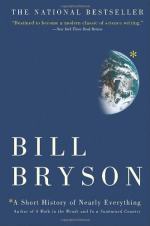
|
| Name: _________________________ | Period: ___________________ |
This test consists of 15 multiple choice questions and 5 short answer questions.
Multiple Choice Questions
1. After noticing an unusual phenomenon with uranium salts and a photographic plate, Henri Becquerel asked one of his graduate students to investigate the matter. Who was this student?
(a) Louise Désirée Lorieux.
(b) René Just Haüy.
(c) Marie Curie.
(d) Wilhelm Conrad Röntgen.
2. A caldera is a:
(a) Chain of islands.
(b) Group of hot springs.
(c) Large crater.
(d) Pointy volcanic peak.
3. Vesto Slipher's work at the Lowell Observatory in Arizona led him to discover that distant stars are moving away from us, with the farthest stars moving the fastest, suggesting that the universe is:
(a) Stable.
(b) Oscillating.
(c) Shrinking.
(d) Expanding.
4. What is found at the very center of the Earth?
(a) Liquid inner core.
(b) Solid inner core.
(c) Gaseous core.
(d) Frozen core.
5. What followed the last supervolcanic eruption on Earth in the region that is now northern Sumatra?
(a) A two-year series of tidal waves.
(b) A reversal of the magnetic poles.
(c) A six-year volcanic winter.
(d) Twenty years of intense earthquakes.
6. When was Pluto discovered?
(a) 1892.
(b) 1930.
(c) 1876.
(d) 1957.
7. In a span of just 20 years, the number of known moons in the solar system grew from:
(a) 10 to more than 25.
(b) 60 to more than 500.
(c) 12 to more than 300.
(d) 30 to more than 90.
8. The fact that Pluto has a moon was not discovered until:
(a) 1978.
(b) 1936.
(c) 1965.
(d) 1991.
9. Earth is composed of 8 to 12 larger plates and about how many smaller ones?
(a) Twenty.
(b) Eighty.
(c) One hundred.
(d) Five.
10. In 1875, why was Max Planck advised against studying physics and urged to study math instead?
(a) Planek knew high-level math but only very basic physics.
(b) It was believed that all the important physics discoveries had already been made.
(c) A career in math offered greater financial opportunities for him.
(d) The government often arrested those who delved in certain branches of physics.
11. What organization opposed geologist Clair Patterson and his campaign?
(a) American Academy of Pediatrics.
(b) American Petroleum Institute.
(c) American Dairy Association.
(d) Swimming Pool Safety Institute.
12. According to the author, humans today have 625 percent more what in their bloodstream compared to previous generations?
(a) Pesticides.
(b) Lead.
(c) Chlorofluorocarbons.
(d) Alcohol.
13. What is a supernova?
(a) A red giant.
(b) A dying star.
(c) A young, emerging star.
(d) A white dwarf.
14. What is the average distance between asteroids found in the inner solar system between Mars and Jupiter?
(a) Ten billion miles.
(b) A million miles.
(c) Ten thousand miles.
(d) A thousand miles.
15. In the 1700s, people were finding holes in theories. For example, if the thoughts on erosion were completely correct, then:
(a) Sand would be ground to fine powder.
(b) There would be no mountains, only smooth hills.
(c) All farmland would have been washed away.
(d) Icebergs would have eroded long ago.
Short Answer Questions
1. In the 1960s, what did Bob Christiansen realize about Yellowstone National Park after observing NASA-supplied images?
2. Arranged side by side, how many atoms can fit across the width of a typical human hair?
3. About how many stars can be seen from Earth using a two-inch telescope?
4. Invented in the 1930s, chlorofluorocarbons (CFCs) have proven to be damaging to:
5. Richard Owen coined the term paleontology as the study of prehistoric life forms and called the giant animals dinosaurian, meaning:
|
This section contains 549 words (approx. 2 pages at 300 words per page) |

|




